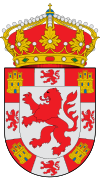Province of Córdoba (Spain)
| Córdoba | |||
|---|---|---|---|
| Province | |||
|
|||
 Map of Spain with Córdoba highlighted |
|||
| Coordinates: 38°00′N 4°50′W / 38.000°N 4.833°WCoordinates: 38°00′N 4°50′W / 38.000°N 4.833°W | |||
| Country | Spain | ||
| Autonomous community | Andalusia | ||
| Capital | Córdoba | ||
| Government | |||
| • President | Antonio Ruiz Cruz (PSOE) | ||
| Area | |||
| • Total | 13,769 km2 (5,316 sq mi) | ||
| Area rank | Ranked 13th | ||
| 2.73% of Spain | |||
| Population (2014) | |||
| • Total | 799,402 | ||
| • Rank | Ranked 18th | ||
| • Density | 58/km2 (150/sq mi) | ||
| 1.78% of Spain | |||
| Demonym(s) | English: Cordovan Spanish: Cordobés |
||
| Official language(s) | Spanish | ||
| Parliament | Cortes Generales | ||
| Website | dipucordoba.es | ||
Córdoba (Spanish pronunciation: [ˈkorðoβa]), also called Cordova in English, is a province of southern Spain, in the north-central part of the autonomous community of Andalusia. It is bordered by the provinces of Málaga, Seville, Badajoz, Ciudad Real, Jaén, and Granada. Its area is 13,769 km². A royal decree of November 30, 1833 created the Province of Córdoba (along with 48 other provinces), which was formed by joining the towns of the Kingdom of Córdoba and the following places in Extremadura: Belalcazar Fuente la Lancha, Hinojosa del Duque and Villanueva del Duque. The province is mainly divided into three geographical areas: the Sierra Morena to the north, the Baetic Depression in the center and La Campiña in the south. The climate is continental Mediterranean with temperatures in the capital ranging from 9.2 °C in January and 27.2 °C in July and August, which often exceed 40 °C. Rainfall in the capital is recorded from 600 to 750 mm per year. It is concentrated from October to April. The province of Cordoba is the 11th in Spain where the entire population is concentrated in the capital. On an average 31.96% of a Spanish province's population inhabits its capital. The province consists of 75 municipalities. They are further grouped into 8 “comarcas”.
...
Wikipedia


